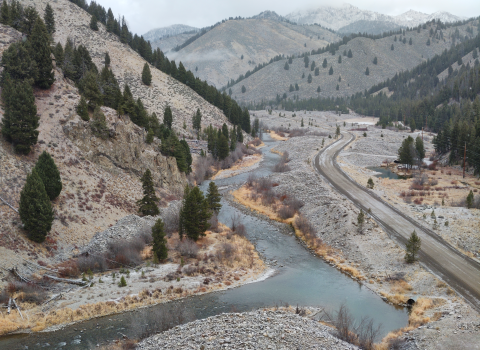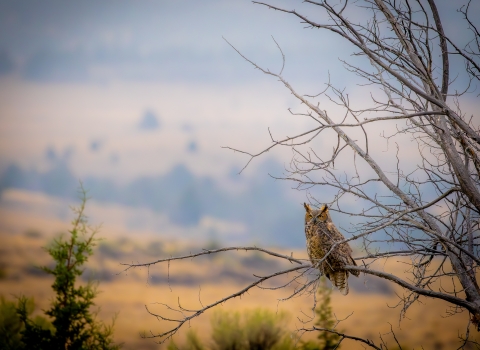A new letter to Conservation Biology, Funding evidence-based conservation,1 offers financial assistance programs ten practical approaches to ensure grant applications are more evidence-based. Signed by representatives of 25 organizations that support conservation projects, the letter’s primary message is that it is important to demonstrate that conservation project proposals are based on the best available evidence. Authors emphasize the opportunity for financial assistance programs to improve conservation outcomes through use of evidence: Asking applicants for funding to assess the evidence for what has worked––and what has not––when designing projects can help identify approaches with a higher likelihood of success, leading to increases in efficacy and improved outcomes.
Matt Muir, one of the letter’s co-signees, and his colleagues in International Affairs are working to realize these benefits to conservation for the Service’s international grantmaking programs. Matt is the Service's first full-time evaluation officer, and sees evidence-based conservation as a trend in financial assistance. “A few years ago, I first noticed Conservation Evidence tools appear in a proposal to a Migratory Birds program and now we see it in International Affairs proposals. Our team in the Division of International Conservation has also been exploring how we can incorporate these tools into our financial assistance cycle. Some staff ask about evidence in program Notices of Funding Opportunities (NOFOs) and in other cases, we’ve checked the evidence ourselves and presented the results to review panelists. We’re also collecting baseline information on evidence use across our grantmaking programs as a new program performance measure.” This type of innovation and exploration is consistent with Matt’s co-authors' experience at other conservation organizations: We stress that we encourage continued innovation and the testing of practices to generate new evidence and that reporting unsuccessful interventions is as important as documenting success.
The letter describes ten practical approaches for ‘ensuring conservation grant applicants reflect on evidence’ through a straightforward table that describes each of the ten approaches and provides an example of organizations that have adopted each approach:
Approach | Description | Examples of Adopting Organizations |
|---|---|---|
| Application form contains a question about evidence | A section in the application form asks about evidence for the effectiveness of any proposed conservation actions. This is a straightforward and effective approach. However, it may be seen as too bureaucratic, time-consuming, or challenging. It may also not be appropriate if most applications do not involve conservation actions or if decision-making takes place at a different stage of project development. | The Whitley Fund for Nature, People's Trust for Endangered Species, Birdlife International, John Spedan Lewis Foundation, North of England Zoological Society, The National Trust, Bat Conservation International, Woodland Trust, Mohamed bin Zayed Species Conservation Fund, The Rufford Foundation, and WCS Climate Adaptation Fund |
| Applicants asked to describe their evidence use somewhere in the proposal | This approach is less formal than having a specific question about evidence in the form. Perhaps more appropriate for smaller grants or applicants less used to applying for funding | People's Trust for Endangered Species, Amphibian Survival Alliance, and Future for Nature Foundation |
| Second application stage asks about evidence | Some funders have an initial short application form, followed by a second stage, in which a subset of applicants provide further details. Funders can ask for evidence of effectiveness of proposed actions in the second stage, where relevant. This can reduce workload in the first stage and permits a general application process for a wide range of projects, with only practical conservation proposals required to provide evidence in the second stage. | Endangered Landscapes Programme |
| Applicants are asked to justify assumptions underpinning their theory of change | Many applications request a theory of change elucidating how the proposed actions are likely to result in the desired outcomes. Funders can ask for the evidence base for the assumptions underlying the theory of change. | Endangered Landscapes Programme |
| Grantees are asked to describe evidence use as part of reporting | The grant application and contract state the expectation that decision-making processes will be evidence based. Grantees’ reports to the funder then describe how evidence was used in decision-making and why key actions were chosen. This is appropriate where key decisions are made during the project, rather than before submitting the application. | n/a |
| Funders check evidence themselves | If assessing evidence is considered too onerous or off-putting for applicants, funders can themselves check the evidence for proposed actions during the selection process. | Future for Nature Foundation and the U.S. Fish and Wildlife Service International Affairs |
| Evidence is considered during project co-development | Some funders may not use a straightforward application process but instead codesign projects with potential grantees. The funder may then identify the evidence and discuss how to use this in project planning with potential grantees. | On the EDGE Conservation |
| Process for using evidence is described | Applicants are asked to describe the process by which relevant evidence will be identified and considered during their project. This may be appropriate for complicated projects requiring numerous decisions or sets of projects (or even an organization) that are funded before details of activities to be undertaken are known. | n/a |
| Evidence use is clearly stated in selection criteria | A transparent criterion makes it clear that only proposals that use evidence-based decision-making will be considered for funding. | Woodland Trust and WCS Climate Adaptation Fund |
| Monitoring and enhancing index of evidence use | Funders monitor the level of evidence use (e.g., percentage of projects or funding supported by evidence) and set targets for annual improvement. | U.S. Fish and Wildlife Service International Affairs |
The full open access letter, including the above table, can be found here. Matt encourages colleagues to also read the supplementary materials that are aimed to be used and adapted as a guide, ‘Evidence-based funding applications: a guide for conservation funders and applicants’. This guide addresses practical questions such as: What is evidence?, Which decisions should be evidence-checked?, How much detail is needed?, How to present evidence, and Guidance for funders on assessing evidence use in applications.
“The letter and guidance are a great resource,” Matt says, “for staff at the Service’s financial assistance programs who are interested in supporting more evidence-based conservation, but are unsure about which approaches are possible for their program and their applicants’ capacity.”
1 Parks, D., Al-Fulaij, N., Brook, C., Butchart, S. H. M., Collomb, J.-G., Cope, D., Dowell, S., Falkingham, B., Frick, W. F., Gibbs, D., Gray, E. E., Heard, N., Leventis, A. T., Mastro, K., Meredith, H., Mickleburgh, S., Miller, F., Muir, M., Nuijten, R. J. M., … Vié, J.-C. (2022). Funding evidence-based conservation. Conservation Biology, 36, e13991. https://doi.org/10.1111/cobi.13991




